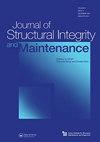Load-settlement response of strip footing overlaid fine sand strengthened with different arrangements of geogrid inclusions
IF 3.1
Q2 ENGINEERING, CIVIL
Journal of Structural Integrity and Maintenance
Pub Date : 2023-01-02
DOI:10.1080/24705314.2022.2142896
引用次数: 1
Abstract
ABSTRACT This study reports the results of experiments conducted on strip foundations with and without reinforced geogrids over fine sand and with a wraparound geogrid arrangement. A load up to 25 kN was applied to the strip foundations to determine the loading-settlement response. These tests examined the number of planar and folded geogrid sheets, the placement of folded geogrids in the soil bed, the thickness of folded geogrid sheets, the length of wraps and overlaps, and the spacing between folded and planar geogrid sheets. The results indicate that the performance of the foundations due to static loading is better for folded geogrid-reinforced sand than for planar geogrid-reinforced sand. Overall, the results demonstrate that reinforced soil foundations with sufficiently folded geogrid layers behave much stiffer and thus can support higher loads with a lower settlement than planar reinforced soils. Moreover, the results indicate that the values of the embedment depth of the overlap element (d), the lower part (D), and the thickness (x) of the folded geogrid are 0.2, 0.4, and 0.2 of the foundation widths (B), respectively. As a result, by increasing the number of geogrid layers, the settlement rate is reduced significantly, and it is recommended that these layers be placed vertically without vertical spacing (h/B = 0).不同布置土工格栅包裹体加固细砂条形基脚的荷载-沉降响应
摘要:本研究报告了在细砂上有或没有加筋土工格栅和包裹式土工格栅的条形基础上进行的试验结果。向条形基础施加高达25kN的荷载,以确定荷载-沉降响应。这些测试检查了平面和折叠土工格栅板的数量、折叠土工网格在土层中的位置、折叠土工程格栅板的厚度、包裹和重叠的长度以及折叠和平面土工格栅之间的间距。结果表明,折叠土工格栅加筋砂土的地基在静载作用下的性能优于平面土工格栅加筋砂土。总体而言,结果表明,与平面加筋土相比,具有充分折叠的土工格栅层的加筋土地基表现得更硬,因此可以以更低的沉降支撑更高的荷载。此外,结果表明,重叠单元的埋置深度(d)、下部(d)和折叠土工格栅的厚度(x)的值分别为基础宽度(B)的0.2、0.4和0.2。因此,通过增加土工格栅层数,沉降率显著降低,建议将这些层垂直放置,无垂直间距(h/B = 0)。
本文章由计算机程序翻译,如有差异,请以英文原文为准。
求助全文
约1分钟内获得全文
求助全文
来源期刊

Journal of Structural Integrity and Maintenance
ENGINEERING, CIVIL-
CiteScore
3.90
自引率
9.50%
发文量
24
 求助内容:
求助内容: 应助结果提醒方式:
应助结果提醒方式:


